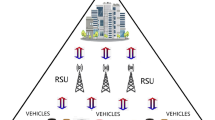Abstract
A fast handover authentication protocol takes an important role for delay-sensitive applications in wireless networks. Mobile users may be granted different priorities depending on communication fees they paid. In this paper, we present a priority-aware anonymous handover authentication protocol using attribute-based cryptography. The proposed protocol realizes mutual authentication, user anonymity, session key establishment and user revocation etc. Particularly it obtains a charming property, namely, user priority. Compared with some existing schemes, it is more efficient while satisfying security.


Similar content being viewed by others
References
Mishra, A., Shin, M., & Arbaugh, W. (2003). An empirical analysis of the IEEE 802.11 MAC layer handoff process. ACM.
Duan, X., & Wang, X. (2015). Authentication handover and privacy protection in 5G hetnets using software-defined networking. Communications Magazine IEEE, 53(4), 28–35.
Fu, A., Zhang, G., Yu, Y., & Zhu, Z. (2014). A privacy preserving vertical handover authentication scheme for WiMAX-WiFi networks. Ksii Transactions on Internet & Information Systems, 8(9), 3250–3265.
Kumar, A., & Om, H. (2016). A secure seamless handover authentication technique for wireless LAN. In International conference on information technology, 2016 (pp. 43–47).
Wang, W., & Hu, L. (2014). A secure and efficient handover authentication protocol for wireless networks. Sensors, 14(7), 11379–11394.
He, D., Khan, M. K., & Kumar, N. (2015). A new handover authentication protocol based on bilinear pairing functions for wireless networks. International Journal of Ad Hoc and Ubiquitous Computing, 18(1/2), 67–74.
He, D., Bu, J., Chan, S., Chen, C., & Yin, M. (2011). Privacy-preserving universal authentication protocol for wireless communications. IEEE Transactions on Wireless Communications, 10(2), 431–436.
Shen, J., Tan, H., Moh, S., Chung, I., Liu, Q., & Sun, X. (2015). Enhanced secure sensor association and key management in wireless body area networks. Journal of Communications & Networks, 17(5), 453–462.
Wang, D., Wang, N., Wang, P., & Qing, S. (2015). Preserving privacy for free: Efficient and provably secure two-factor authentication scheme with user anonymity. Information Sciences, 321, 162–178.
He, D., Wang, D., Xie, Q., & Chen, K. (2017). Anonymous handover authentication protocol for mobile wireless networks with conditional privacy preservation. Science China Information Sciences, 60(5), 052104.
He, D., Ma, M., Zhang, Y., Chen, C., & Bu, J. (2011). A strong user authentication scheme with smart cards for wireless communications. Computer Communications, 34(3), 367–374.
Yang, G., Wong, D. S., & Deng, X. (2007). Anonymous and authenticated key exchange for roaming networks. IEEE Transactions on Wireless Communications, 6(9), 3461–3472.
He, D., Chan, S., Chen, C., Bu, J., & Fan, R. (2011). Design and validation of an efficient authentication scheme with anonymity for roaming service in global mobility networks. Wireless Personal Communications, 61(2), 465–476.
Zhang, M., & Fang, Y. (2005). Security analysis and enhancements of 3GPP authentication and key agreement protocol. IEEE Transactions on Wireless Communications, 4(2), 734–742.
Lee, C. C., Hwang, M. S., & Liao, I. E. (2006). Security enhancement on a new authentication scheme with anonymity for wireless environments. IEEE Transactions on Industrial Electronics, 53(5), 1683–1687.
He, D., Chen, C., Chan, S., & Bu, J. (2012). Secure and efficient handover authentication based on bilinear pairing functions. IEEE Transactions on Wireless Communications, 11(1), 48–53.
Li, G., Jiang, Q., Wei, F., & Ma, C. (2014). A new privacy-aware handover authentication scheme for wireless networks. Wireless Personal Communications, 80(2), 581–589.
Jing, Q., Zhang, Y., Fu, A., & Liu, X. (2011) A privacy preserving handover authentication scheme for EAP-based wireless networks. In Global telecommunications conference, 2011 (pp. 1–6).
He, D., Chen, C., Chan, S., & Bu, J. (2012). Analysis and improvement of a secure and efficient handover authentication for wireless networks. IEEE Communications Letters, 16(8), 1270–1273.
Yeo, S. L., Yap, W. S., Liu, J. K., & Henricksen, M. (2013). Comments on “Analysis and Improvement of a Secure and Efficient Handover Authentication Based on Bilinear Pairing Functions”. IEEE Communications Letters, 17(8), 1521–1523.
Jo, H. J., Paik, J. H., & Dong, H. L. (2014). Efficient privacy-preserving authentication in wireless mobile networks. IEEE Transactions on Mobile Computing, 13(7), 1469–1481.
Sultan, N. H., & Sarma, N. (2014). PAPAR: Pairing based authentication protocol with anonymous roaming for wireless mesh networks. In International conference on information technology, 2014 (pp. 155–160).
Kwon, H., Kim, D., Hahn, C., & Hur, J. (2016). Secure authentication using ciphertext policy attribute-based encryption in mobile multi-hop networks. Multimedia Tools & Applications, 2016, 1–15.
Alpár, G., Batina, L., Batten, L., Moonsamy, V., Krasnova, A., et al. (2016) New directions in IoT privacy using attribute-based authentication. In ACM international conference on computing frontiers, 2016 (pp. 461–466).
Boneh, D., Boyen, X., & Goh, E.-J. (2005). Hierarchical identity based encryption with constant size ciphertext. In Annual international conference on the theory and applications of cryptographic techniques, 2005 (pp. 440–456). Springer.
Sahai, A., & Waters, B. (2005) Fuzzy identity-based encryption. In International conference on theory and applications of cryptographic techniques, 2005 (pp. 457–473).
Goyal, V., Pandey, O., Sahai, A., & Waters, B. (2006) Attribute-based encryption for fine-grained access control of encrypted data. In ACM conference on computer and communications security, 2006 (pp. 89–98).
Chen, C., Zhang, Z., & Feng, D. (2011). Efficient ciphertext policy attribute-based encryption with constant-size ciphertext and constant computation-cost. Berlin: Springer Berlin Heidelberg.
Ansi, X. (1999). Public Key cryptography for the financial services industry: The elliptic curve digital signature algorithm (ECDSA).
Acknowledgements
The authors would like to thank the anonymous reviewers and the editor for their comments that will help to improve this paper. This work was supported by Innovative Research Groups of the National Natural Science Foundation of China (No. 61521003).
Author information
Authors and Affiliations
Corresponding author
Additional information
Publisher's Note
Springer Nature remains neutral with regard to jurisdictional claims in published maps and institutional affiliations.
Rights and permissions
About this article
Cite this article
Li, G., Zeng, Y., Guang, H. et al. A Priority-Aware Anonymous Handover Authentication Protocol for Wireless Communications. Wireless Pers Commun 114, 2613–2627 (2020). https://doi.org/10.1007/s11277-020-07492-y
Published:
Issue Date:
DOI: https://doi.org/10.1007/s11277-020-07492-y




